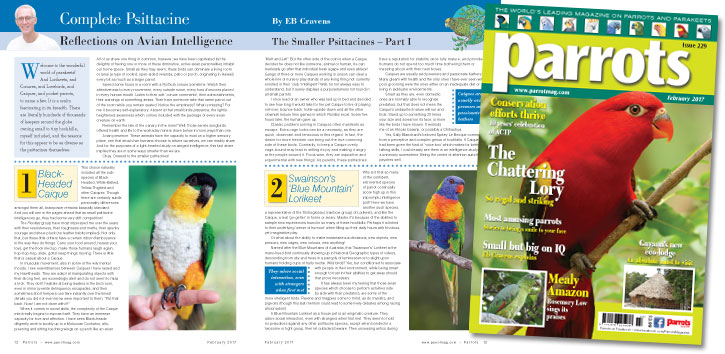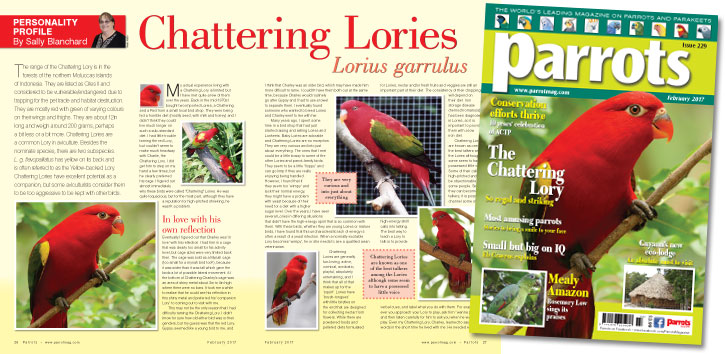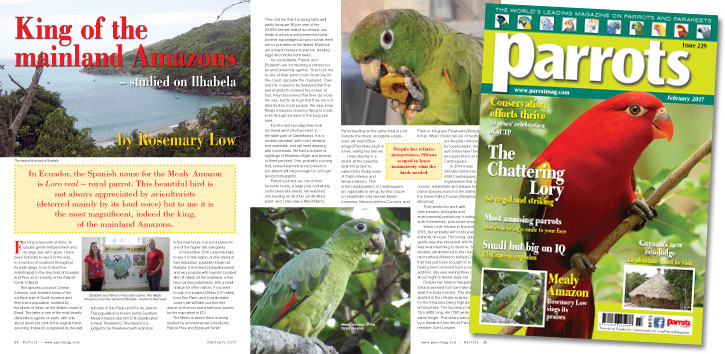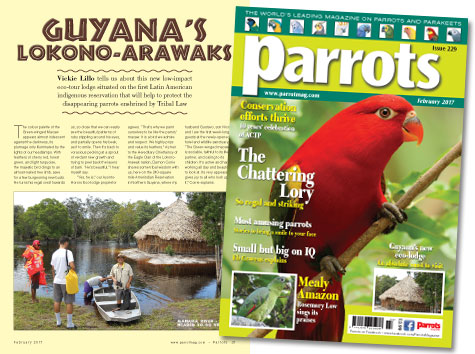
Complete Psittacine by Eb Cravens
Welcome to the wonderful world of parakeets!
And Lorikeets, and Conures, and Lovebirds, and Caiques, and pocket parrots, to name a few. It is a realm fascinating in its breadth. There are literally hundreds of thousands of keepers around the globe owning small to tiny hookbills, myself included, and the reasons for this appear to be as diverse as the psittacines themselves.
All of us share one thing in common, however, we have been captivated by the delights of having one or more of these diminutive, active avian personalities inhabit our home space. Small as they may seem, these birds can dominate a living room or lanai (a type of roofed, open-sided veranda, patio or porch, originating in Hawaii) every bit as much as a larger parrot.
Spend some hours in a room with a Pyrrhura conure sometime. Watch their attentiveness to every movement, every outside noise, every hors d'oeuvres placed in every human mouth. Listen to their soft ‘conure comments’, their admonishments, their warnings of something amiss. Then have someone take that same parrot out of the room while you remain seated. Notice the emptiness? What is missing? For me it becomes self-explanatory. Absent is that small birdie presence, the lightly-heightened awareness which comes included with the package of every avian creature on earth.
Buy Now!

Personality Profile by Sally Blanchard
The range of the Chattering Lory is in the forests of the northern Moluccas islands of Indonesia. They are listed as Cites II and considered to be vulnerable/endangered due to trapping for the pet trade and habitat destruction. They are mostly red with green of varying colours on their wings and thighs. They are about 12in long and weigh around 200 grams, perhaps a bit less or a bit more. Chattering Lories are a common Lory in aviculture. Besides the nominate species, there are two subspecies. L. g. flavopalliatus has yellow on its back and is often referred to as the Yellow-backed Lory. Chattering Lories have excellent potential as a companion, but some aviculturists consider them to be too aggressive to be kept with other birds.
My actual experience living with a Chattering Lory is limited but I have met quite a few of them over the years. Back in the mid-1970s I bought two imported Lories, a Chattering and a Red from a small local bird shop. They were being fed a horrible diet (mostly seed, with milk and honey) and I didn’t think they could live much longer on such a sub-standard diet. I had little trouble taming the red Lory, but couldn't seem to make much headway with Charlie, the Chattering Lory. I did get him to step on my hand a few times, but he clearly preferred his cage. I figured out almost immediately why these birds were called "Chattering" Lories. He was quite loquacious, but for the most part, although they have a reputation for high-pitched shrieking, he wasn’t a problem.
Buy Now!

by Rosemary Low
In Ecuador, the Spanish name for the Mealy Amazon is Loro real – royal parrot. This beautiful bird is not always appreciated by aviculturists (deterred mainly by its loud voice) but to me it is the most magnificent, indeed the king, of the mainland Amazons.
For long a favourite of mine, its usually gentle temperament and its large size set it apart. I have been fortunate to see it in the wild in a number of locations throughout its wide range, from Costa Rica (virenticeps) to the clay licks of Ecuador and Peru and, recently, in the Atlantic forest of Brazil.
Buy Now!

Vickie Lillo tells us about this new low-impact eco-tour lodge situated on the first Latin American indigenous reservation that will help to protect the disappearing parrots enshrined by Tribal Law.
The colour palette of the Green-winged Macaw appears almost iridescent against the darkness, its plumage only illuminated by the lights of our headlamps. With feathers of cherry red, forest green, and light turquoise, the majestic bird clings to an almost-naked tree limb, save for a few burgeoning new buds. He turns his regal crest towards us, so close that we can easily see the beautiful patterns of ruby stippling around his eyes, and partially opens his beak, as if to smile. Then it’s back to voracious pecking at a sprout of verdant new growth and trying to peel back the layers of bark. “He’s beautiful,” I hear myself say.
Buy Now!




